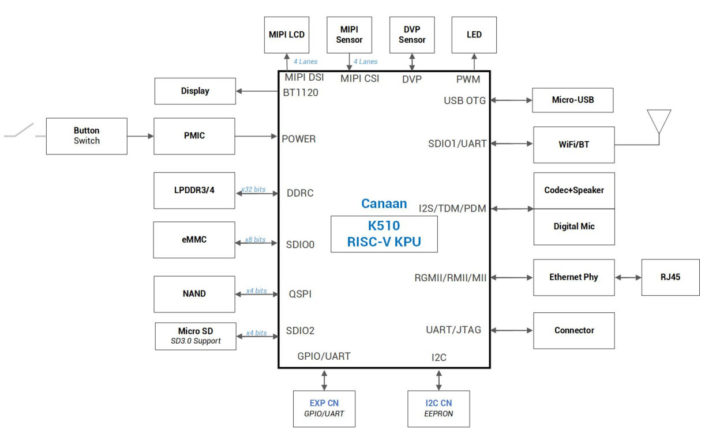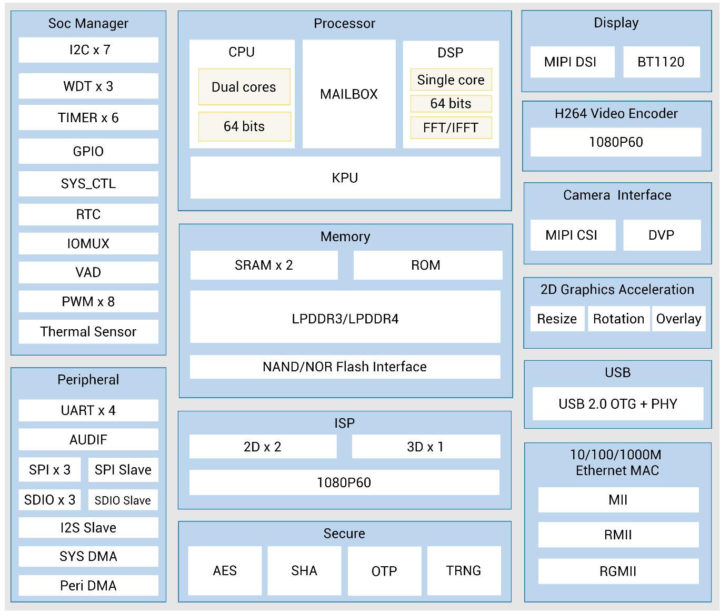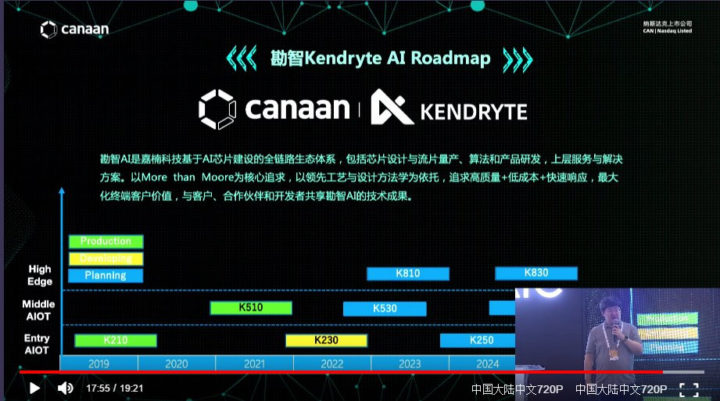Kendryte K510 is a 64-bit tri-core RISC-V processor clocked at up to 800 MHz with AI accelerators that succeed the 400 MHz Kendryte K210 dual-core RISC-V AI processor released a few years ago first in Kendryte KD233 board, and then boards like Maxduino or Grove AI HAT conveniently programmable with Arduino or Micropython.
Canaan formally announced the processor yesterday at the 2021 World Artificial Intelligence Conference claiming K510 had three times the performance of K210 making it suitable for UAV high-definition aerial photography, high-definition panoramic video conferences, robotics, STEAM education, driver assistance scenarios, and industrial and professional cameras.
The press release did not have much information, but multiple sources provided additional details to CNX Software, so we have Kendryte K510 specifications:
- Processor – 2x 64-bit RISC-V processor @ 800 MHz, and 1x 64-bit RISC-V core @ 800 MHz with DSP extension
- AI subsystem with 3 TOPS in total
- KPU: General Neural Network Engine (GNNE)
- Fast Fourier Transform (FFT): Decimation-in-time (DIT) Radix-2 FFT/IFFT
- Voice Activity Detection (VAD) supports 512kHz PDM, 16kHz PCM
- Memory
- Static RAM (SRAM) – 1 MB SRAM0 and 512 KB SRAM1
- Double Data Rate (DDR) – LPDDR3/LPDDR4
- Storage I/F – eMMC flash, SPI NAND flash,3x SD hosts and 1x SD slave block
- Video processing unit -H.264 encoder, JPEG encode
- Display I/F – MIPI DSI, MIPI DPHY TX, two-dimensional engine, and BT1120.
- Camera I/F – MIPI CSI, MIPI DPHY RX, ISP-2D, ISP-3D, and FBC
- Audio – PDM/TDM/I2S mode audio data as receiver and transmitter
- Networking – 10/100/1000Mbps Gigabit Ethernet MII/RMII/RGMII interfaces
- USB – USB On-the-Go (OTG) Dual-role device controller for a single peripheral device.
- Serial – 4x UARTs with RS485 interfaces
- Other peripherals
- 3x SPI master controllers and 1x SPI slave controller
- 32x GPIO
- 2x 4-bit PWM
- 4-channel SDMA (System DMA) for transactions between DDR and SRAM
- 16-channel PDMA (Peripheral DMA) for transactions between peripherals and DDR/SRAM
- Security
- One Time Program (OTP)
- Physical Un-clone Function (PUF)
- Advanced Encryption Standard (AES)
- Secure Hash Algorithm (SHA)
- Misc – Temperature sensor: 3℃ untrimmed accuracy (-40℃ to 100℃), 12-bit resolution, and power management; RTC, watchdog timer, 6x 32-bit timers
- Manufacturing process – 28nm

The processor can boot from SPI NAND flash, eMMC flash, the SD card, or even from UART. Kendryte K210 was interesting to play with but the performance is limited, and for instance, I got 15 to 18 fps in a face detection/tracking demo, and this type of lag is not suitable for robotics applications. Going from 1 TOPS to 3 TOPS in Kendryte K510 will certainly help with applications demanding faster response times. What I did not see are efficiency numbers in watts per TOPS. [Update: the company published some power consumption numbers: Typical power 2W; Standby Current < 2mA. ]
We’ve been told the SDK was still under development, and that stock would be limited to a few K samples this year due to the current lack of 28nm chip product capacity. So it’s more likely to become broadly available in 2022. That means manufacturers of low-cost AI camera boards will have to switch to other solutions such as Rockchip RV1109 processor this year.
Canaan also provides a longer term roadmap up to 2025 for Kendryte AI / AIoT RISC-V processors with two low-end processors coming in 2022 (K230) and 2024 (K250), two mid-range processors to succeed to K510 including K530, and high-end edge processor, I suppose for AI edge gateways, coming in 2023 and beyond with Kendryte K810 and K830.

Jean-Luc started CNX Software in 2010 as a part-time endeavor, before quitting his job as a software engineering manager, and starting to write daily news, and reviews full time later in 2011.
Support CNX Software! Donate via cryptocurrencies, become a Patron on Patreon, or purchase goods on Amazon or Aliexpress






I hope they fixed the MMU in this thing so you can actually boot proper Linux.
What is the issue here?
Nothing is broken in K210, but it does not come with an MMU, so it’s more difficult to run Linux without randomly crashing.
That’s not correct. The K210 has an MMU and a perfectly functional one at that. The CPU core, cache, MMU complex is I believe basically straight Berkeley “Rocket” RISC-V as at the time Kendryte designed the SoC. The problem is that was the pre-ratification Privileged Architecture version 1.9.1, not the ratified 1.10, and they are incompatible.
The bigger problem with running Linux on a K210 is simply that 8 MB is not enough to run a modern Linux kernel.
OK. I stand corrected. I’ve always thought K210 only got Linux NOMMU support because there was no MMU.
And the NPU operates in 4 of that 8MB of RAM, effectively leaving 4MB for kernel, caches, and userspace. That was the minimum requirement for linux 0.8 in text mode on 386 if you wanted to use dialup with lynx and pine for web and email in 1993.
I realize its sort of quasi-asic (app specific), but sux to have to wait until 2022 for 28 nm, when x86, Mac, and ARM are going 4-6 nm.
Silicon vendors just select the manufacturing process best suited for their target application.
For instance, I think many microcontrollers are still manufactured with 55nm to 90nm processes.
I think 28nm/22nm is currently the ideal point for power consumption and cost per transistor, it’s an obvious choice for this type of entry-level SoC. Rockchip RV1109 is in a similar market with a 14nm implementation, but that’s still the exception.
As they seem to have their own NPU design, they probably went with the same process as before to save development cost, but scaled it up from 0.5 TOPS in K210 to 3 TOPS, which is an impressive upgrade. I guess they freed up a lot of area by replacing the on-chip 8MB SRAM with the LP-DDR4 controller.
It’s notable that with the additional I/O (DRAM, USB, MMC, ethernet), the chip should actually be usable as a low-end Linux client machine, but it’s notably still lacking stuff like PCIe, GPU and USB3 that one would otherwise want.
If it does what you need it to do within the price, power etc criteria you have why does something you can’t see without millions of dollars of specialist equipment matter?
Half asleep when you wrote this? “Most low-cost AI camera boards will likely be based on Allwinner chips like RV1109 or R329 this year.”
I went out on a limb based on feedback from one vendor. I’ve now rephrased that.
RV1109 is made by Rockchip
R329 is a speaker chip not a camera one.
I know where the R329 is coming from. Somebody is working on making an AI camera board with R329 plus a USB camera. Not sure why just yet.
Hopefully they release the full reference manual (datasheet with all the register details, etc) to the public. They were hostile to anyone requesting access to the reference manual on K210 which is why I never ended up using it. Its a shame because 64bit dual/triple core RISC-V looks very cool.
Sidenote: If know where I can find the K210 full reference manual, that would be super cool.
@Yofie
Kendryte K210 TRM is acctually not very useful. It is just a set of .md files with only a little bit more information than can be found in SDK .h files. You can use DesignWare manuals as most perpherals are compatible.
Hopefully, there will be the full Techincal Refference Manual available for K510.
Is it just me, or are you ready to start seeing Star Wars amounts of robots roaming everywhere?
Well, the force is all in on RISC-V. Well, as long as Darth Jensen, General Gelsinger, and Count Segars don’t spoil the party along with an army of clones from Emperor Pooh.
Canaan published some power consumption numbers:
Typical power 2W;
Standby Current < 2mA.
What is the cost of K210 by reel?